SIGHTS OF INTEREST
You can stay in St. Petersburg for a month and see just half of its
riches. You'll agree with us after your visit to St. Petersburg :).
We'll try to write here about the major sights that you can explore
at your leisure. To get the flavor of Moscow, you would walk along Tverskaya
Street or Stary Arbat; to sample St. Petersburg, walk down Nevsky Avenue, a long
and straight shopping and sightseeing avenue. As most of the sights of interest
are located downtown. You are advised to go on foot because the metro and the
bus lines are not the most convenient means for getting around. So...
Nevsky Avenue is St. Petersburg's favorite street, the center of business as
well as social and cultural activities. There are theaters, concert halls,
cinemas, galleries, hotels, restaurants, pubs, shops, and quiet public gardens
for you to enjoy. Nevsky Avenue is adjoined by squares and crossed by the Moika
and Fontanka Rivers, the Griboyedov Canal.
The initial road was cut through swamps in 1710 to connect the Admiralty with
Aleksander Nevsky Monastery at the other end of this avenue. Paved with the
logs, it soon became the main street of the new capital and it was named Nevsky
Prospekt (Avenue) in 1730. Many nobles built their mansions along the avenue.
For example, the Stroganov Palace, now is a part of the Russian Museum. The
well-known baroque architect Bartolomeo Rastrelli built it in 1754 for Count
Aleksandr Stroganov, president of the Academy of Arts.
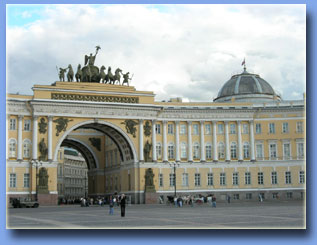 |
Palace Square (Dvortsovaya Ploshchad') is possibly one of the best starting
points for exploring St. Petersburg. Created by architect Carlo Rossi it's the
focal point of the city. It was formed after the construction of the Winter
Palace (now the part of the Hermitage
Museum), the residence of Russian tsars.
Two long buildings, with a total length of 1.739 feet and connected by an arch,
form a horseshoe around the square in front of the Winter Palace. This ensemble
is called the General Staff Building, which traditionally served as Russia's
military headquarters. The Triumphal Arch connecting the two parts of the
General Staff Building carries the Chariot of Victory drawn by six
horses (more pictures here).
In the center of the square is the Alexandr Column, erected in 1834. Both the
155-foot-high column and the arch commemorate the Russian's victory over
Napoleon. The angel on the top of the column symbolizes peace in Europe after
the Napoleonic invaders were defeated. Palace Square bore witness to many
historical events, including Bloody Sunday in January 1905, when tsarist
soldiers massacred unarmed demonstrators. Twelve years later, the Bolshevists
also attacked the Winter Palace from this square.
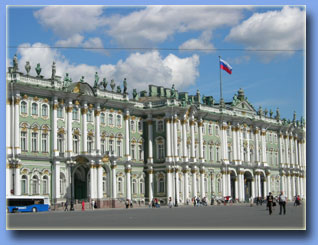 |
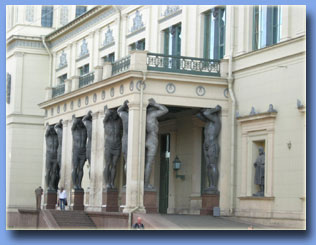 |
The Winter Palace (so called Hermitage) which dominates the Square replaced earlier crowded royal
residences and rose in its present form between 1754 and 1762 in the reign of
Empress Elizabeth. Bartolomeo Fransco Rastrelli (later ennobled by his
patroness) succeeded in creating an outstanding example of what is known as
Russian Baroque. The Palace consists of four large blocks stretching between the
Square and the embankment which contain the main State apartments and more than
a thousand halls and rooms.
By the time the building was completed Catherine the Great was on the throne
and Baroque was out of fasion, Classicism being the vogue. The outside was not
tampered with, but the interiors were entrusted to new craftsmen, Yuri Felten,
Vallin de la Mothe and Giacomo Quarenghi, who all worked in the latest style. In
1837 the Winter Palace was gutted by fire, and all that remained was the walls.
But within two decades it was restored, and most of its present interiors date
from then. Under the czars it was the main Imperial residence, and was used for
ceremonial occasions, grand balls, and receptions.
The complex next to the Winter Palace is the Small Hermitage (more
pictures here). Its building was
started by Catherine II who wanted to have a home for the art collection
connected to her private apartments in the Winter Palace. The whole museum
complex (i.e. the Winter Palace and the various Hermitage buildings such as
Small Hermitage, Large Hermitage, Old and New Hermitage (sometimes grouped
together and called the Large Hermitage), Hermitage Theater) is now known as the
"State Hermitage".
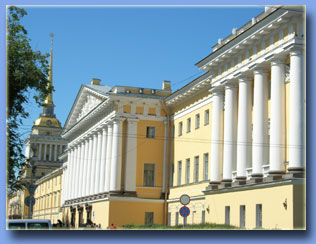 |
The architectural complex of the Palace Square is completed by the Admiralty
(more pictures here).
In the early days of St. Petersburg a moated fort containing a well - protected
wharf was here. The Admiralty yard with its stores, workshops and slipways was
at first the largest industrial undertaking in the new capital. The Admiralty
was reconstructed several times and the building was handed to the Russian navy
in 1840s. There are 28 statues on the top of upper columns of the tower. The
Admiralty spire with the caravelle on top of it is one of the landmarks of St.
Petersburg and it can be seen from many parts of the city. The weather vane is
in the shape of a sailing vessel. Ships continued to be built here up to the
1840s but, in the later part of last century, canals leading into the site were
filled in as the embankment was laid leading away from the Winter Palace to what
was then Senate Square and now is the Square of the Decembrists.
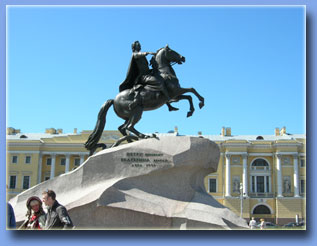 |
Senate Square, which is southwest of the Admiralty, together with the Synod
was built in 1834. The square originally served as parade grounds. In the garden
between the Senate and the Admiralty is the statue Bronze Horseman, made famous
by Aleksander Pushkin's poem of the same name. It's a monument to Peter the
Great and was erected in 1782 by Catherine the Great. It was sculpted from a
granite block that weighed 1,600 tons and took 400 men four months to roll it
from the Gulf of Finland. During Soviet times Senate Square was called
Decembrists' Square to honor the liberal guard officers who staged an
unsuccessful overthrow of Tsar Nicholas I by refusing to swear allegiance to the
newly - crowned emperor on December 14, 1825. The five leaders of the
Decembrists, now remembered as the participants, were hanged in the nearby Peter
and Paul Fortress, and several hundred others were exiled to Siberia. (more
pictures here)
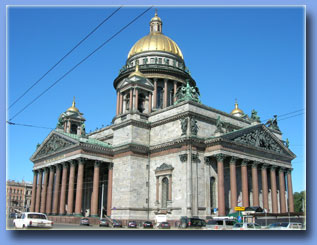 |
Adjacent to the south western corner of Senate Square is St. Isaac's Square
with the magnificent gold-domed St. Isaac's
Cathedral. Begun in 1818, it took 40
years and more than 400,000 workers to complete. The cathedral's vaults, walls
and pylons are decorated with some 150 murals depicting biblical subjects. There
are 62 mosaic panels in the cathedral.
The structure was named after St. Isaac of Dalmatia whose day, according to
the church calendar, is May 30, when Peter the Great was born. Three hundred and
thirty-five feet high, it's believed to be on of the tallest domed buildings in
the world. The cathedral can accommodate 14,000 worshipers. Climb the 262 steps
to the colonnade and enjoy the city's panorama.
Across the square from the cathedral, on the bank of the Moika River, stands
Mariinsky Palace, built in 1844 for Nicholas's daughter Mariya.
Kazan Cathedral, constructed in Russian classical style in 1811 on the plans
of Count Stroganov's serf, who was eventually granted his freedom. The
70-meter-high cruciform structure is modeled on St. Peter's Cathedral in Rome.
In 1813, fieldmarshall Mikhail Kutuzov, the commander of the Russian forces
during the 1812 Napoleonic invasion of Russia, was laid to rest here. In 1837,
monuments to Kutuzov and other heroes of the 1812 war were erected on the Nevsky
prospect side of the cathedral.
Glinka Philarmonic Hall, it was once St. Petersburg's major music center
where such illustrious composers as Hector Berlioz, Richard Wagner and Franz
Liszt performed.
Church of the Resurrection (Our Savior on the Blood), built in 1907
on the
spot where tsar Aleksandr II was assassinated in 1881. Designed in a Russian
style, it resembles St. Basil's Cathedral in Moscow. Mosaic attire of the church (over 7,000
sq.m.) was created to the design of
30 artists, among them Vasnetsov, Nesterov, Ryabushkin, Belyaev, Kharlamov.
Gostiny Dvor and the Passazh (Arcade), the city's two oldest shopping
galleries are at the beginning of the widest part of Nevsky Avenue.
Aleksander Nevsky Monastery, founded by Peter the Great in 1710 on the spot
where the Novgorod prince, Alexander Nevsky, is said to have won a great victory
over the Swedes and the Teutonic Knights in 1240. In 1797 it became a lavra (
the highest religious status in Russian Orthodox Church). One of the four most
important monasteries in pre-revolutionary Russia.
Aleksander Nevsky Bridge, almost one kilometer long and the longest of all
the Neva River bridges. There are some 330 bridges spanning rivers in St.
Petersburg.
Mikhaylovskaya Street leads you from Nevsky Avenue to Arts Square, laid out
by architect Carlo Rossi. Here is the well-known Russian Museum. This building,
erected in 1825, was the palace of Grand Prince Mikail Pavlovich, the younger
brother of Emperor Aleksander I and Nicholas I. It was bought by the state at
the end of 19th century and turned into a museum of exclusively Russian art.
The Mars Field, a huge square to the north from Russian museum. It was the
scene of 19th -century military parades. Now it honors those killed in the Civil
War and the 1917 Revolution (see pictures here).
Summer Garden, laid out in 1704, is to the east from the Field of Mars. It's
the first sculpture garden of Russia in the 18th century. There are more than
250 statues and busts here.
Anichkov Bridge, that crosses the Fontanka River is named after the man who
built the first wooden bridge here in the early 18th century. The bridge is
interesting for the four rearing horses decorating its corners. In the 18th
century Fontanka marked St. Petersburg's boundaries. Anichkov Palace is on one
end of the bridge. Elizabeth, the daughter of Peter the Great, presented to
Count Aleksey Razumovsky, her favorite. Tsar Nicholas I gave balls in this
palace. Aleksander Pushkin's wife, Nataliya, often dazzled everyone, including
the tsar, with her beauty.
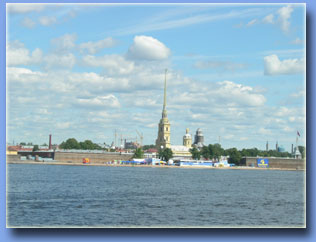 |
The Peter and Paul Fortress (Petropavlovskaya
krepost') on little Zayachy
Island, Peter the Great first broke ground for St. Petersburg and built this
fortress in 1703. Peter planned it as a defence against the Swedes but defeated
them before it was finished. Its main use up to 1917 was as a political prison;
one of its first inmates was Peter's own son Alexey, whose torture Peter is said
to have overseen personally. Other famous residents were Dostoevsky, Gorky,
Trotsky and Lenin's brother, Aleksander.
You are welcome to Saint-Petersburg! |